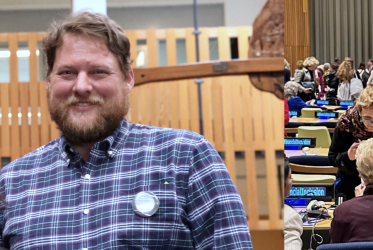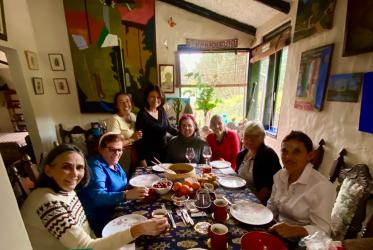Scripture: John 4: 3-42
3 He left Judea and started back to Galilee. 4 But he had to go through Samaria. 5 So he came to a Samaritan city called Sychar, near the plot of ground that Jacob had given to his son Joseph. 6 Jacob’s well was there, and Jesus, tired out by his journey, was sitting by the well. It was about noon.
7 A Samaritan woman came to draw water, and Jesus said to her, ‘Give me a drink’. 8 (His disciples had gone to the city to buy food.) 9 The Samaritan woman said to him, ‘How is it that you, a Jew, ask a drink of me, a woman of Samaria?’ (Jews do not share things in common with Samaritans.) 10 Jesus answered her, ‘If you knew the gift of God, and who it is that is saying to you, “Give me a drink”, you would have asked him, and he would have given you living water.’ 11 The woman said to him, ‘Sir, you have no bucket, and the well is deep. Where do you get that living water? 12 Are you greater than our ancestor Jacob, who gave us the well, and with his sons and his flocks drank from it?’ 13 Jesus said to her, ‘Everyone who drinks of this water will be thirsty again, 14 but those who drink of the water that I will give them will never be thirsty. The water that I will give will become in them a spring of water gushing up to eternal life.’ 15 The woman said to him, ‘Sir, give me this water, so that I may never be thirsty or have to keep coming here to draw water.’
16 Jesus said to her, ‘Go, call your husband, and come back.’ 17 The woman answered him, ‘I have no husband.’ Jesus said to her, ‘You are right in saying, “I have no husband”; 18 for you have had five husbands, and the one you have now is not your husband. What you have said is true!’ 19 The woman said to him, ‘Sir, I see that you are a prophet. 20 Our ancestors worshipped on this mountain, but you say that the place where people must worship is in Jerusalem.’ 21 Jesus said to her, ‘Woman, believe me, the hour is coming when you will worship the Father neither on this mountain nor in Jerusalem. 22 You worship what you do not know; we worship what we know, for salvation is from the Jews. 23 But the hour is coming, and is now here, when the true worshippers will worship the Father in spirit and truth, for the Father seeks such as these to worship him. 24 God is spirit, and those who worship him must worship in spirit and truth.’ 25 The woman said to him, ‘I know that Messiah is coming’ (who is called Christ). ‘When he comes, he will proclaim all things to us.’ 26 Jesus said to her, ‘I am he, the one who is speaking to you.’
27 Just then his disciples came. They were astonished that he was speaking with a woman, but no one said, ‘What do you want?’ or, ‘Why are you speaking with her?’ 28 Then the woman left her water-jar and went back to the city. She said to the people, 29 ‘Come and see a man who told me everything I have ever done! He cannot be the Messiah, can he?’ 30 They left the city and were on their way to him.
31 Meanwhile the disciples were urging him, ‘Rabbi, eat something.’ 32 But he said to them, ‘I have food to eat that you do not know about.’ 33 So the disciples said to one another, ‘Surely no one has brought him something to eat?’ 34 Jesus said to them, ‘My food is to do the will of him who sent me and to complete his work. 35 Do you not say, “Four months more, then comes the harvest”? But I tell you, look around you, and see how the fields are ripe for harvesting. 36 The reaper is already receiving wages and is gathering fruit for eternal life, so that sower and reaper may rejoice together. 37 For here the saying holds true, “One sows and another reaps.” 38 I sent you to reap that for which you did not labour. Others have laboured, and you have entered into their labour.’
39 Many Samaritans from that city believed in him because of the woman’s testimony, ‘He told me everything I have ever done.’ 40 So when the Samaritans came to him, they asked him to stay with them; and he stayed there for two days. 41 And many more believed because of his word. 42 They said to the woman, ‘It is no longer because of what you said that we believe, for we have heard for ourselves, and we know that this is truly the Saviour of the world.’
The Text in its Context
When the northern kingdom of Israel was captured by the Assyrians and its people carried away to captivity, non-Jewish foreigners settled in the region of Samaria and intermarried with the remaining Jewish residents. Their descendants were called Samaritans.
In Shechem, also known as Sychar, Abraham and Jacob had both built altars to mark their encounters with God. Jacob’s well, that is mentioned in the gospel passage, is in Shechem, and the ‘holy mountain’ mentioned by the Samaritan woman would be the nearby Mount Gerizim. Shechem was a major and political centre, second only to Jerusalem. Shechem was for the Samaritans what Jerusalem was for the Jews. But Samaritans and Jews were hostile toward each other’s holy sites. In 112-111 BC, John Hyrcanus, the Hasmonean ruler who governed the south, destroyed the Samaritan temple on Mount Gerizim. And in 6 AD, a group of Samaritans desecrated the Jerusalem temple by scattering human bones in it.
Galileans travelling in groups would sometimes journey through the region of Samaria for festivals in Jerusalem in the south, risking heckling and possible violence from Samaritans. However, pious Jews would cross over the Jordan River and take a longer route, preferring to travel around Samaria to avoid interactions with Samaritans, whom they regarded as heretics and unclean. They would avoid handling any vessel or utensil touched by a Samaritan. But for Jesus, defilement came from within, not from without, and so he took the shortest route, which was along the top of the ridge that passed by Sychar and Jacob’s well.
Jesus walked with his disciples and grew weary. The gospel of John has a high view of the person of Jesus, the divine Word that became flesh and dwelt among us. But in that same gospel, Jesus is very human. He gets tired and thirsty. His humanity is as unmistakable as his divinity. Sitting by the well, he sets the stage for his interactions with the Samaritan “Woman at the Well.”
Middle Eastern village women avoided the heat of day by carrying water from the village well early in the morning and just before sundown. For propriety’s sake, they always went to and from the well as a group. And they helped position the heavy full water jars on each other’s heads. The woman in our story appears at the well alone, at noon. There is an implication that she was a social outcast.
Perhaps she was viewed as an immoral woman. Too often, this is how she has been portrayed because Jesus said to her, “you have had five husbands, and the one you have now is not your husband.” Let’s explore her possible background and then see how Jesus interacted with her.
It was customary in New Testament times and earlier for people to marry young. Girls were married almost as soon as they were physically able to bear children. They could have been as young as 13. In most cases, marriages were arranged by the respective parents. The view in the ancient world – and even in many places today – was that marriage was not so much about love and romance as it was about survival. It was not just the individuals who were married. Their two families came together in mutual support.
It was highly likely that the Samaritan woman in our story entered an arranged marriage while still a young teenager. But how was it possible that by the time she met Jesus, she had been married five times and was now living with a sixth man? Was she a glamourous, seductive woman, married and divorced several times, like Hollywood celebrities such as Elizabeth Taylor and Zsa Zsa Gabor?
The more probable explanation is that she somehow displeased her first husband who divorced her and sent her back to her father. Subsequently, she may have been married off to an older man and if he died without leaving any children, his brother could claim her as his wife and expect her bear children. But if she could not have children, perhaps because she could not carry a pregnancy to its full term, he could divorce her. Her shame as a barren, rejected woman would become grist for public gossip in her town. She may have married another older man, one who did not expect her to bear him children, but who left her a widow again.
Any of her marriages could have ended in widowhood or in divorce initiated by the husband because women did not have the right to ask for divorce. By the end of her fifth marriage, the Samaritan woman would have been battered in body and soul, and possibly without a home or any income. She may have moved in with a man who at least gave her a roof over her head; but the vicissitudes of life left her exposed to the censure of her fellow villagers. The Samaritan woman went to the well alone at midday, as she was probably ostracised by the women in her village,. To her surprise, a Jewish man was sitting by the well and he asked her for a drink of water.
The Text in Our Context
We are not told the woman’s name. She is just referred to either as the “woman at the well,” or “the Samaritan woman.” She is anonymous, yet the record of her encounter with the Lord Jesus is one of the longest in the gospel of John. Her extraordinary conversation with the Messiah, the opening of her mind and heart to his message of salvation, empowered her to bear witness among the very people who had despised her.
In making his request, Jesus did four things:
- He broke a social taboo against talking to a woman. In ancient Middle Eastern village society, unknown men did not even make eye contact with a woman in a public place. But Jesus not only talked with women, he invited them into his band of disciples. He was financially supported by some women and some travelled with him (Lk 8:1-3). Jesus introduced, demonstrated, and lived out a radically positive change in attitudes towards women, an example that far too few men have followed in subsequent centuries.
- Jesus ignored the centuries-old hostility between Jews and Samaritans. In asking for a drink from the Samaritan woman, he set aside all the bitterness of history.
- Within this interaction, there is a profound theology of mission. Jesus humbled himself as a supplicant. He did not establish his interaction with her by explaining how she needed him and his message. Rather, his opening line, “Give me a drink,” meant, “I am weak and need help! Can you help me?”
The first “mission trip” in Christian history was the sending out of the twelve disciples (Mk. 6:7-13). They were commanded to “take nothing for their journey except a staff; no bread, no bag, no money in their belts; but to wear sandals and not put on two tunics.” They were to go in need of the people to whom they went.
A baby in a manger is the ultimate example of one in need of those to whom he or she comes. The incarnation affirms this profound theology. As an adult engaged in his ministry, Jesus lived out this same theology of vulnerability, of willingness to be seen as needy, including with the Samaritan woman. His request for a drink of water was genuine because he had no bucket. He understood the need to be a receiver.
- Jesus elevated the woman’s self-worth. The woman’s dignity was affirmed by being asked to help Jesus out of her available resources.
A male Jew, a most irregular rabbi, speaks with a female Samaritan! Two outcasts who discuss together the nature of spirituality and truth. They confront the history of their respective religious traditions and find common ground that transcends their tensions.
The Samaritan woman appeared to be without guile or defensiveness, rather she was ready and eager to have her religious hopes fulfilled. When Jesus stated that she was living with one who was not her husband, she showed no anger. When Jesus declared that salvation would come from the Jews, she remained open-minded and attentive.
As they conversed, Jesus led the woman to understand the nature of God and Jesus’ own mission. Discarding her apparent initial disdain of him as a “Jew,” intrigued by what he says to her, she called him “Sir,” a title of respect. She moved on to recognize that Jesus was “a prophet,” and later, she was receptive when he affirmed that he is the Messiah. This is what she told the people in her city, leading many Samaritans to believe that Jesus is “the Saviour of the world.”
She was moved by her encounter with the countercultural Christ who treated her like a person, someone worthy of his notice and attention. Not judging her for her supposed murky past, affirming her shared humanity, he regarded her as someone who deserved to hear the truth about who he was and who she was.
She was so exhilarated that she paid no attention to the probably sexist vibes from the returning disciples, but, overflowing with joyous amazement, hurried back to the people who probably ostracised her. Risking rejection, she gave a simple witness, “Come and see a man who told me everything I have ever done!” Her life laid opened, she simply shared what she had experienced and now believed. And the people followed her.
Finding Jesus neither judgmental nor unfriendly, the woman engaged with Jesus in a question-and-answer dialogue. And sensing her spiritual thirst, Jesus took the conversation deeper, explaining not just the difference between spirit and matter, but the significance of worship in one’s heart rather than in a particular place. To worship in spirit is to worship God from the deepest part of our being, anytime and anywhere. With the Holy Spirit within us, God’s very presence with us, worship is not confined to particular places or buildings.
The Samaritan woman epitomises the evangelist’s purpose for writing his gospel. John explains, “But these are written so that you may come to believe that Jesus is the Messiah, the Son of God, and that through believing you may have life in his name” (John 20:31).
Questions for reflection
- What do you think is meant by the title of this study: “A double whammy”?
- What were your previous impressions of the Samaritan woman?
- How did you feel when you read about the possible reasons why she would have had five husbands?
- Give a few reasons why people may be ostracised today. Is such exclusion ever justified?
- Have you ever been misjudged or socially condemned unfairly? How did that feel at the time? How did you respond?
- Jesus broke the boundaries of religion and culture. How can we break the boundaries of religious and cultural biases so as to accept and learn from others different from us?
- What is attractive about the way Jesus interacted with the Samaritan woman?
An Ignatian-style imaginative contemplation
You are invited to mull over, to contemplate on the gospel story of the “Woman at the Well,” using your imagination to enter the scene, to take part, to let the scene unfold. This type of prayer is practised in Ignatian spirituality.
Take a few minutes to prepare your body and mind. Choose a position where you can be relaxed but alert. Breathe deeply several times and let your body relax. Breathe out any worrying or stressful thoughts and leave them in God’s hands. Become aware of God’s presence with you now. He looks at you with love.
Slowly read through the scripture passage in John 4. Even read through it a second time. Imagine the well. What does it look like?
In your imagination, look around, widen your focus. What is near the well? Trees, grass, perhaps desert? Take your time as you imagine the scene.
What kind of day is it? Hot, dry, cool, windy, or a gentle breeze? What can you hear? Animal noises, birds chirping, silence? What can you smell? Again, take your time as you use your senses.
You have just arrived at the well at midday. Take a moment to orient yourself. Jesus is sitting at the far side of the well. You draw near and he greets you. What does he say?
He asks you for a drink of water. How do you respond?
The two of you have a conversation. Do you draw nearer and sit down or remain standing? You wonder if there is any insight about your own life that Jesus has to offer you. Ask him. How does he respond? Let your conversation continue for a while.
And how do you feel about Jesus’ willingness to spend time with you?
When you are ready to go, what do you say in farewell to Jesus?
Conclude this time of prayer, this contemplation, with a time of stillness.
Resources
Bailey, Kenneth E. Jesus Through Middle Eastern Eyes: Cultural Studies in the Gospels. Downers Grove, IL: IVP Academic, 2008.
Driscoll, Martha E. Reading Between the Lines: The Hidden Wisdom of Women in the Gospels. Liguori, MO: Liguori, 2006.
Getty-Sulllivan, Mary Ann. Women in the New Testament. Collegeville, MN: Liturgical Press, 2001.
Japinga, Lynn. Feminism and Christianity: An Essential Guide. Nashville: Abingdon Press, 1999.
Short bio of the writer
Betty Talbot loves teaching and watching people learn to love learning, be it the periodic table in a science lesson or understanding the role of the scapegoat in a Bible study in Leviticus.
Betty has been blessed with many opportunities in different circumstances to be involved in teaching. She has taught science in high schools in Sydney, produced innovative teaching modules on human rights and refugee issues for UNHCR, the UN Refugee Agency, has led weekly Bible studies for over 25 years in various countries, and has served as a Licensed Lay Minister in Anglican churches in Paris and Geneva. She currently serves at La Côte Anglican Church in Switzerland.






